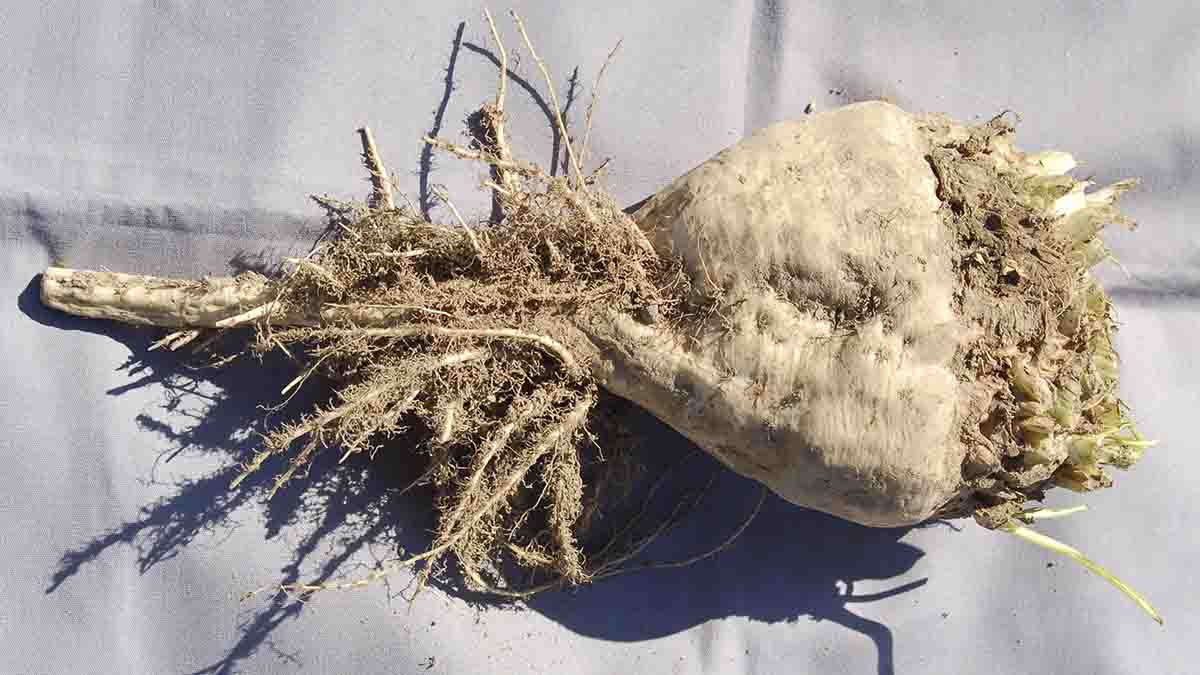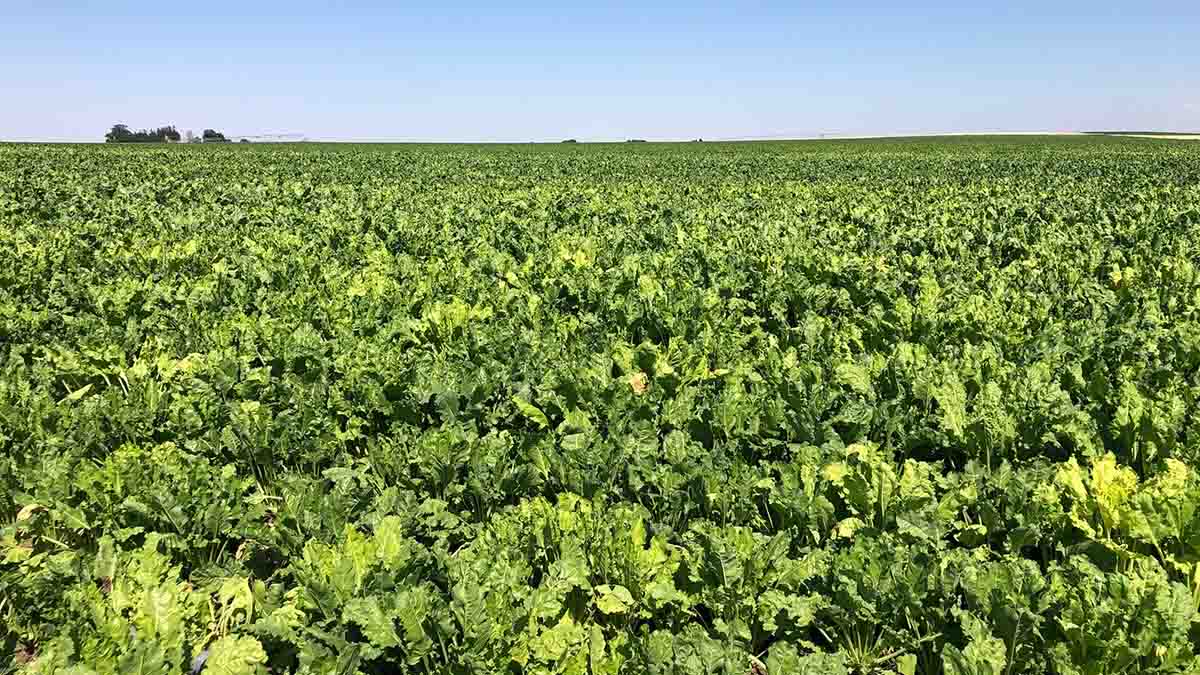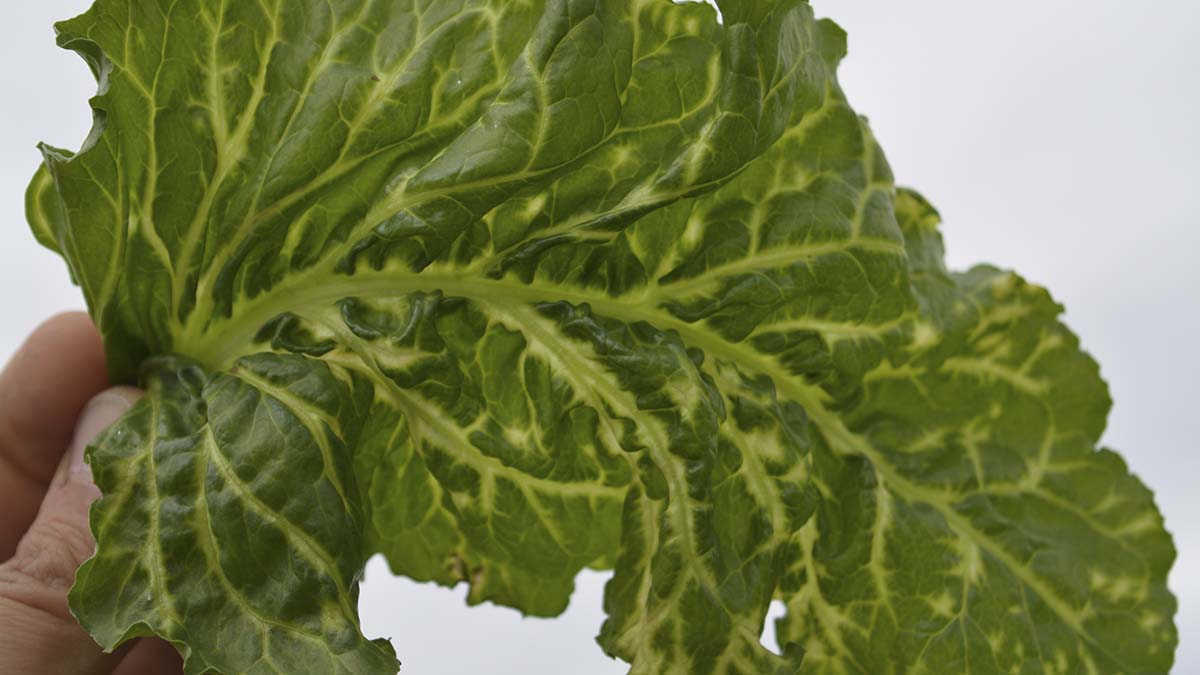Rhizomania
Pest Common Name
- Disease name — Rhizomania
- Disease organism — Beet Necrotic Yellow Vein Virus (Benyvirus)
- Crops including sugar beet, spinach, Swiss chard, table beet and quinoa
- Weeds including bindweed, broad-leaved plantain, creeping thistle, jimsonweed, kochia, lambsquarters and puncture vine
Rhizomania causes serious losses in sugar beet crops in Idaho and sugar beet growing regions around the world. The symptoms that develop, and their severity differ based on the developmental stage of the sugar beet plant at the time of infection. Plants infected early in the season are more likely to express severe symptoms, while plants infected late in the season may have only mild symptoms or even no obvious symptoms at all.
Infected, symptomatic roots may be stunted and take on a wineglass shape (Figure 1), while proliferation of lateral rootlets may give the root a “bearded” appearance (Figure 2). Roots infected early often show light brown discoloration of vascular tissue, particularly around infected rootlets, when cut longitudinally (Figure 3). Beets infected later in the season often do not show obvious discoloration of the vascular tissue. Foliar symptoms include leaves with a narrow, erect growth habit. Leaf discoloration can range from only slight yellowing to severe bright, fluorescent yellowing . Though the severity of symptoms is often associated with the time of infection, note that the severity of aboveground symptoms does not always correlate with the severity of root symptoms and associated losses.



Biology
The symptoms of rhizomania are caused by the beet necrotic yellow vein virus (BNYVV) , which is spread by the fungal vector Polymyxa betae. BNYVV and P. betae primarily infect plants in the same genus as sugar beet (Beta), though both have hosts outside of this genus.
P. betae is ubiquitous in the soil. Though it requires a living host to reproduce and spread, cysts and cystosori (groups of cysts) may survive in the soil for more than 10 years. Cysts germinate and release infectious zoospores only when in the vicinity of the roots of a suitable host and when the soil is between 59- and 82-degrees Fahrenheit (15°C and 28°C) and nearly saturated. Once they infect host cells, zoospores will either continue to multiply or cystosori will form if roots die. The lifecycle of P. betae can repeat with every irrigation, potentially rapidly increasing inoculum levels.
Not all zoospores of the fungal vector P. betae are viruliferous (contain BNYVV). Nonviruliferous P. betae cells do not spread rhizomania and cause minimal damage to host plants. However, viruliferous zoospores can transmit BNYVV to the host plant and cause the above-described symptoms of rhizomania once it infects host plant cells, BNYVV stays confined to the cells near the point of initial infection and is reliant upon the fungal vector for further spread to other rootlets and through the soil. The fungal vector P. betae also does not rapidly spread, moving only a few inches per year through the soil. However, even small amounts of soil transported via equipment, irrigation water or other means can easily transport P. betae containing BNYVV, and thus spread rhizomania.
Damage
Rhizomania can cause serious damage to sugar beet crops. Losses are most severe when plants are infected early in the growing season. Economic losses derive from decreased root production (overall harvest weight), decreased sucrose concentrations within the roots, as well as decreased storability. Plants infected later in the season often only suffer slightly reduced root quality, so economic losses are less severe.
Foliar symptoms are often easy to spot, with bright, fluorescent yellow plants (known as blinkers) occurring in isolation (Figure 4) or distributed throughout the field (Figure 5). Under severe disease pressure, foliage may be stunted, and coloration will be uniformly bright. Under lower pressure or when infection occurs later in the season, foliar symptoms are milder, but a uniformly lime green discoloration is usually still evident. The necrotic yellow veins that give beet necrotic yellow vein virus (BNYVV) is name are rarely observed in the field (Figure 6). Note that the severity of foliar symptoms does not always correlate with the severity of root symptoms and associated economic loss. Furthermore, symptoms of BNYVV become harder to spot late in the season when the uniform chlorosis of leaf tissue caused by the virus can be mistaken for nitrogen deficiency.



Plants with rhizomania suffer higher rates of secondary infection causing further stunting, decrease sugar content and purity, and increase losses during storage. Secondary infection may occur as conditions that favor P. betae (e.g., high soil moisture and temperature around 77°F [25°C], neutral to alkaline soils and short rotations) also favor many other pathogens. Furthermore, impaired root function associated with BNYVV infection increases susceptibility to other pathogens.
Monitoring
When monitoring for rhizomania, keep in mind that the severity of foliar symptoms does not always correlate with the severity of root symptoms. Therefore, it is important to collect multiple plants throughout the field to get an accurate sense of disease prevalence and severity. When scouting for foliar symptoms, look for plants with bright, fluorescent yellow leaf discoloration and an unusually erect growth habit. Symptomatic plants, known as blinkers for their bright coloration, are usually scattered throughout the field in newly infested ground or in fields planted with a resistant variety. After three to four plantings in infested ground symptomatic plants are likely to be more uniformly spread throughout the field.
Though symptoms of rhizomania are relatively easy to spot early in the season, they may be confused with nitrogen deficiency or naturally yellowing in the crop canopy later in the season. Contact your local extension educator or crop consultants with questions on testing for rhizomania.
Management
Primary Management Tactics
The fungal vector of rhizomania, P. betae, cannot currently be managed with fungicides, but planting of BNYVV-tolerant sugar beet varieties may limit its buildup and reduce severity of rhizomania symptoms. Cultural practices that interrupt the diseases cycle are also recommended.
Cultural
- Plant varieties tolerant to BNYVV in fields where there is a history of rhizomania. No variety is completely immune to rhizomania symptoms but tolerant varieties (ideally with a combination of the two known resistance genes, Rz1 and Rz2) can achieve good yield under moderate BNYVV pressure.
- Implement a minimum of a four-year rotation to reduce buildup of the vector P. betae
- Promote good drainage and avoid overly wet soil conditions (-30 to 0 centibars) that favor rhizomania. To manage soil moisture, consider the following practices:
- Irrigate to fill the soil profile and then wait as long as possible to irrigate again
- Avoid compaction and/or break up compacted layers
- Plant early, when soil temperatures are at or below 59 degrees Fahrenheit, to allow beets to be established before conditions favor P. betae
- Achieving row closure with strong plant density and height keeps soil temperatures cooler which can reduce rhizomania pressure
- Minimize stress from weeds, insects and other diseases to reduce losses from rhizomania
- When possible, avoid moving soil that may contain the vector of BNYVV or sanitize anything that may move soil such as farm equipment, irrigation water, tare dirt, livestock and people.
Chemical
- There are no known chemicals for the control of P. betae
Further reading
- Harveson, R.M., Hanson, L.E., Hein, G.L. 2009. Compendium of Beet Diseases and Insects. 2nd Edition. St. Paul, MN: APS Press. https://apsjournals.apsnet.org/doi/book/10.1094/9780890546598
- Neher, O. and Gallian, J.J. 2014. Rhizomania on Sugar Beet: Importance, Identification and Control in the Northwest. Pacific Northwest Extension Publication. PNW 657. https://www.lib.uidaho.edu/digital/uiext/items/uiext32318.html
Pesticide Warning
Always read and follow the instructions printed on the pesticide label. The pesticide recommendations in this University of Idaho webpage do not substitute for instructions on the label. Pesticide laws and labels change frequently and may have changed since this publication was written. Some pesticides may have been withdrawn or had certain uses prohibited. Use pesticides with care. Do not use a pesticide unless the specific plant, animal or other application site is specifically listed on the label. Store pesticides in their original containers and keep them out of the reach of children, pets and livestock.
Trade Names — To simplify information, trade names have been used. No endorsement of named products is intended nor is criticism implied of similar products not mentioned.
Groundwater — To protect groundwater, when there is a choice of pesticides, the applicator should use the product least likely to leach.
- Figures 1-6. Oliver T. Neher
Desiree Wickwar, Entomologist, IPM Project Manager
Oliver T. Neher, Plant Pathologist, ASC
2023












